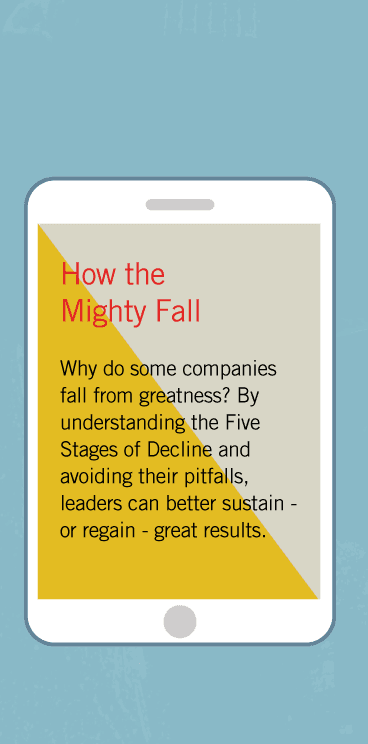Can You Grow into Level 5 Leadership?
“I don’t know for certain that you absolutely must be a Level 5 leader to make your company great,” I replied. “I will simply point back to the data: of 1,435 companies that appeared on the Fortune 500 in our initial candidate list, only eleven made the very tough cut into our study. In those eleven, all of them had Level 5 leadership in key positions, including the CEO, at the pivotal time of transition.”
She sat there, quiet for moment, and you could tell everyone in the room was mentally urging her to ask the question. Finally, she said, “Can you learn to become Level 5?”
My hypothesis is that there are two categories of people: those who do not have the seed of Level 5, and those who do. The first category consists of people who could never in a million years bring themselves to subjugate their egoistic needs to the greater ambition of building something larger and more lasting than themselves. For these people, work will always be first and foremost about what they get—fame, fortune, adulation, power, whatever—not what they build, create, and contribute.
The great irony is that the animus and personal ambition that often drive people to positions of power stand at odds with the humility required for Level 5 leadership. When you combine that irony with the fact that boards of directors frequently operate under the false belief that they need to hire a larger-than-life, egocentric leader to make an organization great, you can quickly see why Level 5 leaders rarely appear at the top of our institutions.
The second category of people—and I suspect the larger group—consists of those who have the potential to evolve to Level 5; the capability resides within them, perhaps buried or ignored, but there nonetheless. And under the right circumstances—self-reflection, conscious personal development, a mentor, a great teacher, loving parents, a significant life experience, a Level 5 boss, or any number of other factors—they begin to develop.
In looking at the data, some of the leaders in our study had significant life experiences that might have sparked or furthered their maturation. Darwin Smith fully blossomed after his experience with cancer. Joe Cullman was profoundly affected by his World War II experiences, particularly the last-minute change of orders that took him off a doomed ship on which he surely would have died. A strong religious belief or conversion might also nurture development of Level 5 traits. Colman Mockler, for example, converted to evangelical Christianity while getting his MBA at Harvard, and later, according to the book Cutting Edge, became a prime mover in a group of Boston business executives who met frequently over breakfast to discuss the carryover of religious values to corporate life. Other leaders in our study, however, had no obvious catalytic event; they just led normal lives and somehow ended up atop the Level 5 hierarchy.
I believe—although I cannot prove—that potential Level 5 leaders are highly prevalent in our society. The problem is not, in my estimation, a dearth of potential Level 5 leaders. They exist all around us, if we just know what to look for. And what is that? Look for situations where extraordinary results exist, but where no individual steps forth to claim excess credit. You will likely find a potential Level 5 leader at work.
For your own development, I would love to be able to give you a list of steps for becoming Level 5, but we have no solid research data that would support a credible list. Our research exposed Level 5 as a key component inside the black box of what it takes to shift a company from good to great. Yet inside that black box is yet another black box—namely, the inner development of a person to Level 5. We could speculate on what might be inside that inner black box, but it would mostly be just that—speculation. So, in short, Level 5 is a very satisfying idea, a powerful idea, and, to produce the best transitions from good to great, perhaps an essential idea. A “Ten-Step List to Level 5” would trivialize the concept.
My best advice, based on the research, is to begin practicing the other good-to-great disciplines we discovered. We found a symbiotic relationship between Level 5 and the remaining findings. On the one hand, Level 5 traits enable you to implement the other findings; on the other hand, practicing the other findings helps you to become Level 5. Think of it this way: This chapter is about what Level 5s are; the rest of the book describes what they do. Leading with the other disciplines can help you move in the right direction. There is no guarantee that doing so will turn you into a full-fledged Level 5, but it gives you a tangible place to begin.
We cannot say for sure what percentage of people have the seed within, or how many of those can nurture it. Even those of us who discovered Level 5 on the research team do not know for ourselves whether we will succeed in fully evolving to Level 5. And yet, all of us who worked on the finding have been deeply affected and inspired by the idea. Darwin Smith, Colman Mockler, Alan Wurtzel, and all the other Level 5s we learned about have become models for us, something worthy to aspire toward. Whether or not we make it all the way to Level 5, it is worth the effort. For like all basic truths about what is best in human beings, when we catch a glimpse of that truth, we know that our own lives and all that we touch will be the better for the effort.






